橡胶成分及分类常识资料
橡胶橡胶分类天然橡胶合成橡胶通用合成橡胶特种合成橡胶一

2、天然橡胶的规格划分
标准胶 (又称颗粒胶) 烟胶片 浓缩胶 白绉胶片 浅色胶片 胶清橡胶 风干胶片等
(1)标准胶划分:
• 5号胶为一级胶,是最好的胶,其所含杂质为0.05%;
一级 SCR5
• 用途:5号胶一般用于制作轮胎内胎;
硅橡胶的应用:
航空、尖端技术、军事技术部门的特种材料使 用,而且也用于国民经济各部门,其应用范围 已扩到:建筑、电子电气、纺织、汽车、机械 、皮革造纸、化工轻工、金属和油漆、医药医 疗等。
6、氟橡胶:
来源:主链或侧链的碳原子上含有氟原子的合成 高分子弹性体。
特质:氟橡胶耐高温、耐油、耐化学腐蚀。是现 代航空、导弹、火箭、宇宙航行等尖端科 学技术不可缺少的材料。
(2)、国内丁苯橡胶主要生产企业与常用牌号:
简称 SBR
规格型号 1500 1502 1712
生产企业 齐鲁石化 吉林石化 兰州石化 南京扬金 南通申华 浙江浙晨
SBR-1500 是通用污染型软丁苯橡胶的最典型品种,生胶的粘着性和加工性能均优, 硫化胶的耐磨性能、拉伸强度、撕裂强度和耐老化性能较好。
来源:由氯丁橡胶聚合而生产的合成橡胶。
特质:溶于氯仿、苯等有机溶剂,在植物油和 矿物油中溶胀而不溶解。有良好的物理 机械性能,耐油,耐热,耐燃,耐日光 ,耐臭氧,耐酸碱,耐化学试剂,缺点 是耐寒性和贮存稳定性较差。
氯丁橡胶的应用:
CR122型:传动带、运输带、电线电缆、耐油胶板、耐 油胶管、密封材料等橡胶制品。
二、通用合成橡胶
1、丁苯橡胶: (1)丁苯橡胶的基础知识:
来源:丁二烯与苯乙烯之共聚合物; 优点:低成本的非抗油性材质,良好的抗水性,硬度 70 以
橡胶元素成分
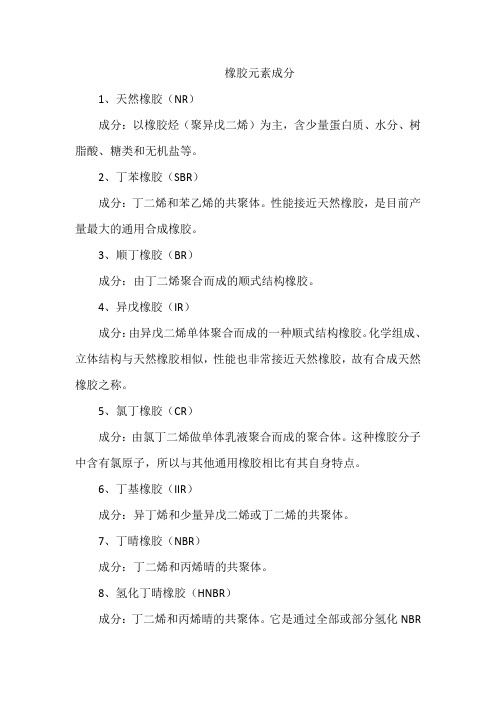
橡胶元素成分
1、天然橡胶(NR)
成分:以橡胶烃(聚异戊二烯)为主,含少量蛋白质、水分、树脂酸、糖类和无机盐等。
2、丁苯橡胶(SBR)
成分:丁二烯和苯乙烯的共聚体。
性能接近天然橡胶,是目前产量最大的通用合成橡胶。
3、顺丁橡胶(BR)
成分:由丁二烯聚合而成的顺式结构橡胶。
4、异戊橡胶(IR)
成分:由异戊二烯单体聚合而成的一种顺式结构橡胶。
化学组成、立体结构与天然橡胶相似,性能也非常接近天然橡胶,故有合成天然橡胶之称。
5、氯丁橡胶(CR)
成分:由氯丁二烯做单体乳液聚合而成的聚合体。
这种橡胶分子中含有氯原子,所以与其他通用橡胶相比有其自身特点。
6、丁基橡胶(IIR)
成分:异丁烯和少量异戊二烯或丁二烯的共聚体。
7、丁晴橡胶(NBR)
成分:丁二烯和丙烯晴的共聚体。
8、氢化丁晴橡胶(HNBR)
成分:丁二烯和丙烯晴的共聚体。
它是通过全部或部分氢化NBR
的丁二烯中的双键而得到的。
9、乙丙橡胶(EPM\\EPDM)
成分:乙烯和丙烯的共聚体,一般分为二元乙丙橡胶和三元乙丙橡胶。
橡胶基本知识介绍

• ① ② ③ ④ ⑤ ⑥ ⑦ ⑧ ⑨
2、顺丁橡胶
•
• ①
②
③ ④
Hale Waihona Puke 顺丁橡胶是以丁二烯为单体,在定向聚合催化剂的作用下,采 用溶液聚合 方法而制得的弹性聚合物。 顺丁橡胶具有如下性能: 顺丁橡胶由于其分子的顺式结构,分子排列规整,所以具有很高的弹 性,比天然橡胶还好,是所有橡胶中弹性最大的一种橡胶。 顺丁橡胶是不饱和橡胶,具有与天然橡胶类似的化学性质,可与硫磺 及氧等反应。与天然橡胶比较,其硫化速度较慢,耐老化和耐热性能 好。 顺丁橡胶是非极性橡胶,能溶于烃类溶剂中,不耐油。 顺丁橡胶加工性能较差,粘着性不好,对加工温度的变化较为敏感。 顺丁橡胶在湿滑地面上易打滑,且生胶的冷流性大。
•
丙烯酸酯橡胶是由丙烯酸酯单体聚合而成,由于丙烯酸酯橡胶结 构的饱和性以及带有极性酯基侧链,因此耐热性能、耐油性能很好, 耐天候老化性能和耐臭氧老化性能良好;但耐水性和耐水蒸汽性能比 较差。
12、氯醇橡胶 • 氯醇橡胶是以环氧氯丙烷为单体制得的一类聚醚型橡胶。它兼具了饱 和橡胶和极性橡胶的通性,分为均聚氯醇胶和共氯醇胶两大类,它们共同 的特性是:
•
• • •
• •
•
① ② ③
7、丁腈橡胶
•
• • • • • • • • 弹性,耐寒性较差 • 电绝缘性差 • 丁腈橡胶的缺点 • 耐臭氧性能不好 • 耐酸性差
丁腈橡胶是由丁二烯和丙烯腈聚合的弹性共聚物。 耐油性能优良 气密性好 丁腈橡胶性能 耐热、耐老化、耐磨等性能优于天然胶 丁腈橡胶能与其他各种橡胶并用
• 通过-50℃到-100℃温度下,通过高速喷射的精细弹丸粒子,高效 地处理包括精密O型圈制品的高精尖产品。
7、二次硫化 • 通过一定温度和时间后加热处理,使氟橡胶、氟硅橡胶和氢化 丁腈等橡胶制品的性能达到最佳状态。 • 用明显的说明时刻提醒和标识产品后处理的状态。
橡胶配方的组成和作用及其分类
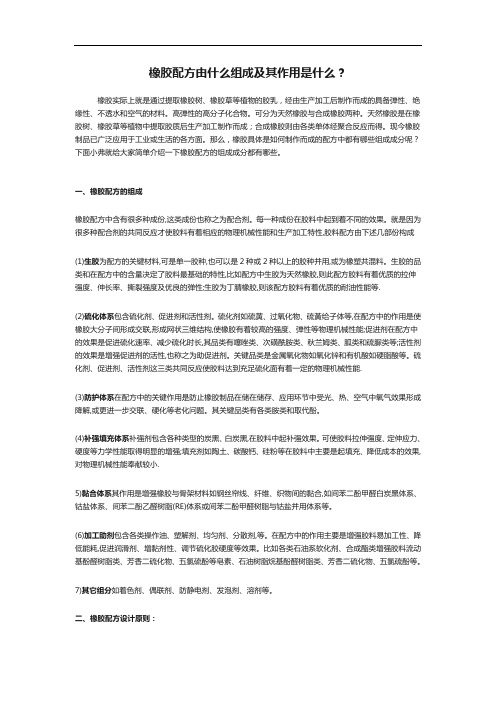
橡胶配方由什么组成及其作用是什么?橡胶实际上就是通过提取橡胶树、橡胶草等植物的胶乳,经由生产加工后制作而成的具备弹性、绝缘性、不透水和空气的材料。
高弹性的高分子化合物。
可分为天然橡胶与合成橡胶两种。
天然橡胶是在橡胶树、橡胶草等植物中提取胶质后生产加工制作而成;合成橡胶则由各类单体经聚合反应而得。
现今橡胶制品已广泛应用于工业或生活的各方面。
那么,橡胶具体是如何制作而成的配方中都有哪些组成成分呢?下面小弗就给大家简单介绍一下橡胶配方的组成成分都有哪些。
一、橡胶配方的组成橡胶配方中含有很多种成份,这类成份也称之为配合剂。
每一种成份在胶料中起到着不同的效果。
就是因为很多种配合剂的共同反应才使胶料有着相应的物理机械性能和生产加工特性,胶料配方由下述几部份构成(1)生胶为配方的关键材料,可是单一胶种,也可以是2种或2种以上的胶种并用,或为橡塑共混料。
生胶的品类和在配方中的含量决定了胶料最基础的特性,比如配方中生胶为天然橡胶,则此配方胶料有着优质的拉伸强度、伸长率、撕裂强度及优良的弹性;生胶为丁腈橡胶,则该配方胶料有着优质的耐油性能等.(2)硫化体系包含硫化剂、促进剂和活性剂。
硫化剂如硫黄、过氧化物、硫黃给子体等,在配方中的作用是使橡胶大分子间形成交联,形成网状三维结构,使橡胶有着较高的强度、弹性等物理机械性能;促进剂在配方中的效果是促进硫化速率、减少硫化时长,其品类有噻唑类、次磺酰胺类、秋兰姆类、胍类和硫脲类等;活性剂的效果是增强促进剂的活性,也称之为助促进剂。
关键品类是金属氧化物如氧化锌和有机酸如硬脂酸等。
硫化剂、促进剂、活性剂这三类共同反应使胶料达到充足硫化面有着一定的物理机械性能.(3)防护体系在配方中的关键作用是防止橡胶制品在储在储存、应用环节中受光、热、空气中氧气效果形成降解,或更进一步交联、硬化等老化问题。
其关键品类有各类胺类和取代酚。
(4)补强填充体系补强剂包含各种类型的炭黑、白炭黑,在胶料中起补强效果。
16种橡胶的化学组成性能特点及主要用途

16种橡胶的化学组成性能特点及主要用途1. 天然橡胶(Natural Rubber,NR)化学组成:主要成分是聚异戊二烯。
性能特点:具有良好的弹性、耐磨性、电绝缘性和耐候性,在常温下具有较大的形变能力,耐热性能较差。
主要用途:轮胎、带、输送带、软管、胶板等。
2. 顺丁橡胶(Polybutadiene Rubber,BR)化学组成:主要成分是聚丁二烯。
性能特点:具有良好的耐磨性、抗老化性和高弹性,但耐腐蚀性较差。
主要用途:轮胎、橡胶鞋底、密封件等。
3. 丁苯橡胶(Styrene Butadiene Rubber,SBR)化学组成:主要成分是丁二烯和苯乙烯。
性能特点:具有优良的耐磨性、强度和耐候性,但耐油性较差。
主要用途:轮胎、橡胶板、橡胶管、地板材料等。
4. 丁酮橡胶(Polyisoprene Rubber,IR)化学组成:主要成分是聚顺丁二烯。
性能特点:具有较好的耐磨性、拉伸强度和弹性,耐腐蚀性较差。
主要用途:医疗手套、弹簧、运动器材等。
5. 丁腈橡胶(Nitrile Rubber,NBR)化学组成:主要成分是丁二烯和丙烯腈。
性能特点:具有优良的耐油性、耐磨性和耐腐蚀性,但耐热性较差。
主要用途:燃油管、密封圈、工业橡胶制品等。
6. 硅橡胶(Silicone Rubber)化学组成:主要成分是聚二甲基硅氧烷。
性能特点:具有优良的热稳定性、耐高低温性、电绝缘性和耐老化性。
主要用途:电子产品、医疗器械、高温密封件等。
7. 丁基橡胶(Butyl Rubber, IIR)化学组成:主要成分是异戊烯和少量的异戊烯和丙烯。
性能特点:具有优良的气密性、耐老化性和耐热性,但耐磨性较差。
主要用途:内胎、胶带、密封圈等。
8. 克鲁橡胶(Chloroprene Rubber,CR)化学组成:主要成分是氯丁二烯。
性能特点:具有良好的耐候性、耐热性和耐老化性,但耐油性较差。
主要用途:防水材料、电缆护套、电子元件等。
9. 氟橡胶(Fluororubber,FKM)化学组成:主要成分是氟化烃。
橡胶的分类及介绍分解

橡胶的分类及介绍分解
橡胶,又称橡胶,是由自然界中的具有可延伸性的液体粘合物组成的
合成树脂,主要由橡胶聚合物,辅酶剂,填料,添加剂,助剂组成。
其具
有非常优异的耐磨性,耐高温,耐油,耐酸,耐碱,耐气候性,密封性,
拉伸性等极高特性。
橡胶分类:
一、根据自然与合成分类:
1.天然橡胶:也称为天然胶乳,是从木质针叶树实质中抽汁取得的,
性能稳定,耐酸碱,耐油,抗氧化,但价格较贵,使用广泛。
2.合成橡胶:合成橡胶是由石化材料经化学反应,加入化学改性剂,
调节耐油,抗氧化等性能而生产的,有两大类:硫丁橡胶和无硫橡胶。
二、根据硫化特性分类:
1.硫丁橡胶:也称为硫丁醇橡胶,是经常用于制造橡胶制品的硫化橡
胶型号,是由丙烯酸丁酯,硫丁醇,尿素勃兰及助剂等按一定比例混合经
加热硫化后而得到的。
它有优异的抗氧化性,耐磨性,耐油性,耐酸碱性,但其价格较贵,使用面积有限。
2.无硫橡胶:是由丙烯酸酯与其他热塑性高分子经加热熔融等物理方
法制成的,其分子结构不含硫键,抗拉伸,耐热,机械强度高,硬度高,
但易老化,价格较低,广泛应用。
橡胶知识简介
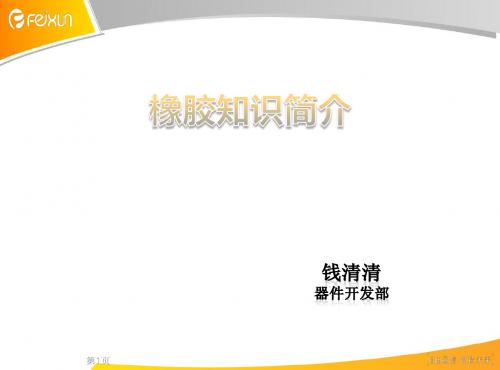
天然橡胶为非极性大分子,具有优良的介电性 能,同时也使它的耐油耐溶剂性差。因天然橡 胶分子结构中含有不饱和双键,易进行氧化、 加成等反应,耐老化性能不佳。
第7页
(2)合成橡胶 合成橡胶可分为通用合成橡胶与特种合 成橡胶两类。 通用合成橡胶一般认为是丁苯橡胶、顺 丁橡胶、异戊橡胶; 特种合成橡胶是丁基橡胶、丁腈橡胶、 乙丙橡胶、硅橡胶、氯醇橡胶、聚氨酯橡 胶、丙烯酸橡胶、聚硫橡胶、氯磺化聚乙 烯及醇烯橡胶等。
第8页
(3)再生胶 再生橡胶是指废旧硫化橡胶经过粉碎、加热、 机械处理等物理化学过程,使其从弹性状态变 成具有塑性和粘性的能够再硫化的橡胶,简称 再生胶。 再生胶生产的主要反应过程是“脱硫“。指从 硫化橡胶中把结合硫磺取出而成为未硫化状态, 也即是一个与硫化相反的解聚作用,实际上并 不能使硫化橡胶中结合的硫磺与橡胶大分子分 离,也不能使硫化胶复原到生胶的结构状态。 所以现在认为硫化胶塑性的恢复,需要破坏 空间交联的结构,其能量的来源是热、机械作 用和化学助剂的塑解作用。
第11页
(四)防老剂 在使用或贮存过程中,由于热、氧、臭氧、阳光 等作用而导致分子链释解、支化或进一步交联等化学 变化,从而使材料原有的性质变坏,这种现象称为老 化。凡能抑制橡胶老化现象的物质叫做防老剂。
第12页
(五)防焦剂 橡胶加工过程中,要经过混炼、压延、压出、 硫化等一系列工序,胶料或半成品要经受不同温 度和时间的处理。 在硫化以前的各个加工操作及贮存过程中,由 于机械作用产生热量或者是高温条件,都有可能 使胶料在成型之前产生早期硫化,导致塑性降低, 从而使其后的操作难以进行,这种现象就称作焦 烧或早期硫化。防止橡胶早期硫化的添加剂,称 为防焦剂。
橡胶原材料分类及相关知识

橡胶原材料分类及相关知识
引言
橡胶是一种常见的材料,广泛应用于制造业中的许多领域。
橡胶原材料的分类
和相关知识对于生产制造过程具有重要意义。
本文将介绍橡胶原材料的分类以及相关知识。
橡胶原材料的分类
根据来源和性质的不同,橡胶原料可以分为天然橡胶和合成橡胶两大类。
天然橡胶
天然橡胶是从橡胶树中提取的橡胶乳,经过干燥、硫化等加工工艺得到的原材料。
天然橡胶具有优良的弹性和耐磨性,广泛用于轮胎、橡胶制品等领域。
合成橡胶
合成橡胶是通过化学合成方法合成的橡胶材料,种类繁多。
合成橡胶可以根据
合成方法、用途等不同进行分类,常见的有丁腈橡胶、丙烯橡胶、氯丁橡胶等。
橡胶原材料的性能
橡胶材料具有许多优良的性能,如弹性、耐磨、耐化学腐蚀等,这些性能使橡
胶成为许多领域不可或缺的材料。
橡胶的性能受到原材料来源、生产工艺等因素的影响,合理选择和处理橡胶原料可以提高制品的品质和性能。
橡胶原材料的应用领域
橡胶原材料广泛应用于各个领域,主要包括汽车制造、建筑工程、医疗器械等。
橡胶制品种类繁多,如轮胎、密封件、橡胶管等,在各个领域都有重要的用途。
结论
橡胶原材料的分类和相关知识对于生产制造过程至关重要。
合理选择和处理橡
胶原材料可以提高制品的品质和性能,促进生产效率的提升。
希望本文对您了解橡胶原材料有所帮助。
以上就是本文关于橡胶原材料分类及相关知识的概述,希望能为您带来新的认
识与启发。
橡胶有关知识点总结

橡胶有关知识点总结一、橡胶的基本概念橡胶是一种高分子聚合物,主要成分是聚异戊二烯,常温下呈胶状。
橡胶具有优良的弹性、耐磨、耐寒和耐酸碱的特性,因而广泛地用于工业和日常生活中。
二、橡胶的性质1. 弹性:橡胶具有良好的弹性,可以拉伸成线状,然后回弹成原状。
2. 耐磨性:橡胶具有很好的耐磨性,适合用于制作汽车轮胎等耐磨耗的产品。
3. 耐寒性:橡胶在低温下仍然保持良好的弹性,不易变硬变脆。
4. 耐酸碱性:橡胶具有一定的耐酸碱性,适合用于化工行业的管道和容器等。
三、橡胶的生产工艺橡胶的生产主要包括天然橡胶和合成橡胶两种,其中合成橡胶是以石油为原料经过聚合反应而得到的,而天然橡胶是从橡胶树中提取而来的。
橡胶的生产包括原料的采集、精炼、聚合等多个环节,生产工艺较为复杂。
四、橡胶的应用领域1. 汽车轮胎:橡胶是汽车轮胎的主要原材料,其良好的弹性和耐磨性能够提高汽车行驶的稳定性和安全性。
2. 鞋底:橡胶制成的鞋底耐磨耗,具有良好的抓地力,适合于户外活动和运动场所。
3. 工业制品:橡胶也被广泛用于工业领域,比如密封件、管道、阀门等。
4. 家居用品:橡胶也被用于制作家居用品,如橡皮泥、橡皮筋等。
五、橡胶的发展趋势1. 高性能化:随着科技的进步,人们对橡胶产品的性能要求越来越高,未来橡胶制品将朝着更高强度、更耐磨耗、更耐老化的方向发展。
2. 绿色环保:在生产过程中,应该尽量减少对环境的污染,采用节能环保的生产工艺,生产出更环保的橡胶产品。
3. 智能化:未来橡胶制品可能会加入智能芯片,实现对产品的智能化管理,提高产品的安全性和可靠性。
六、橡胶的保养与维护1. 温度:橡胶产品不宜放置在高温下,以免变硬变脆。
2. 防水:在橡胶制品长时间浸泡在水中后,要及时晒干,避免发霉和变质。
3. 防腐:橡胶制品在长时间不使用时,应保持干燥,避免霉菌的滋生。
4. 避免接触酸碱物质:橡胶制品不宜接触强酸和强碱,以免发生化学反应而损坏产品。
七、橡胶的环保问题1. 废橡胶的处理:废橡胶的处理一直是一个环保难题,目前主要有回收再利用和焚烧处理两种方式。
橡胶的分类
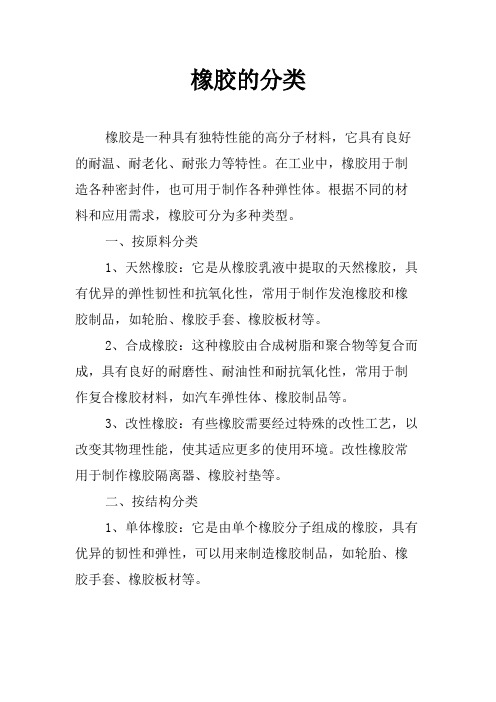
橡胶的分类橡胶是一种具有独特性能的高分子材料,它具有良好的耐温、耐老化、耐张力等特性。
在工业中,橡胶用于制造各种密封件,也可用于制作各种弹性体。
根据不同的材料和应用需求,橡胶可分为多种类型。
一、按原料分类1、天然橡胶:它是从橡胶乳液中提取的天然橡胶,具有优异的弹性韧性和抗氧化性,常用于制作发泡橡胶和橡胶制品,如轮胎、橡胶手套、橡胶板材等。
2、合成橡胶:这种橡胶由合成树脂和聚合物等复合而成,具有良好的耐磨性、耐油性和耐抗氧化性,常用于制作复合橡胶材料,如汽车弹性体、橡胶制品等。
3、改性橡胶:有些橡胶需要经过特殊的改性工艺,以改变其物理性能,使其适应更多的使用环境。
改性橡胶常用于制作橡胶隔离器、橡胶衬垫等。
二、按结构分类1、单体橡胶:它是由单个橡胶分子组成的橡胶,具有优异的韧性和弹性,可以用来制造橡胶制品,如轮胎、橡胶手套、橡胶板材等。
2、复合橡胶:由多种橡胶分子组成的复合橡胶,具有良好的耐磨性、耐温性、耐抗氧化性和耐老化性,常用于制作橡胶制品,如橡胶隔离器、橡胶密封件等。
三、按用途分类1、橡胶制品:橡胶制品是用于日常使用和工业生产的各种橡胶制品,如橡胶轮胎、橡胶管、橡胶手套、橡胶板材等。
2、橡胶密封件:橡胶密封件是用于密封的各种橡胶制品,如橡胶垫片、橡胶垫圈、橡胶垫圈等。
3、橡胶隔离器:橡胶隔离器是用于隔离的各种橡胶制品,如橡胶垫片、橡胶垫圈、橡胶波纹管等。
四、按材质分类1、聚氯乙烯(PVC)橡胶:它是一种高分子材料,具有良好的耐磨性、耐温性、耐抗氧化性和耐老化性,常用于制作橡胶制品,如橡胶管、橡胶垫片等。
2、氯丁橡胶:它是一种高分子材料,具有优异的耐磨性、耐温性、耐抗氧化性和耐老化性,常用于制作橡胶制品,如橡胶轮胎、橡胶衬垫等。
3、氟橡胶:它是一种特殊的橡胶材料,具有优异的耐油性、耐热性、耐抗氧化性和耐老化性,常用于制作复合橡胶制品,如橡胶隔离器、橡胶衬垫等。
因此,橡胶可根据原料、结构、用途和材质等方面分为多种类型。
橡胶原料基本知识
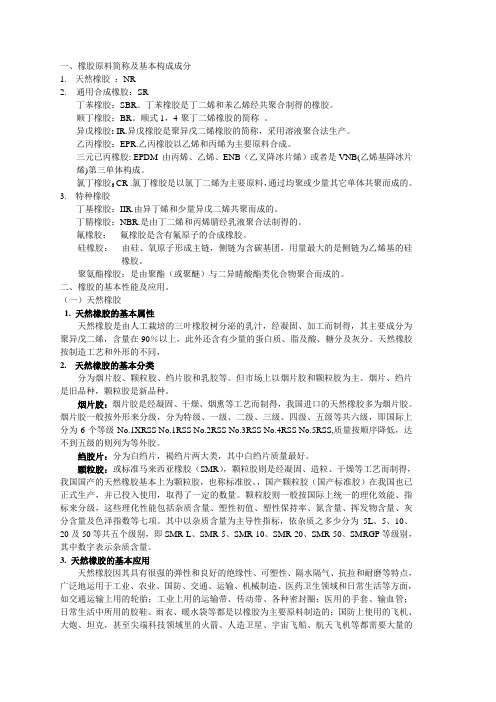
一、橡胶原料简称及基本构成成分1. 天然橡胶:NR2.通用合成橡胶:SR丁苯橡胶:SBR。
丁苯橡胶是丁二烯和苯乙烯经共聚合制得的橡胶。
顺丁橡胶:BR。
顺式1,4-聚丁二烯橡胶的简称。
异戊橡胶: IR.异戊橡胶是聚异戊二烯橡胶的简称,采用溶液聚合法生产。
乙丙橡胶:EPR.乙丙橡胶以乙烯和丙烯为主要原料合成。
三元已丙橡胶: EPDM 由丙烯、乙烯、ENB(乙叉降冰片烯)或者是VNB(乙烯基降冰片烯)第三单体构成。
氯丁橡胶:CR .氯丁橡胶是以氯丁二烯为主要原料,通过均聚或少量其它单体共聚而成的。
3. 特种橡胶丁基橡胶:IIR.由异丁烯和少量异戊二烯共聚而成的。
丁腈橡胶:NBR.是由丁二烯和丙烯腈经乳液聚合法制得的。
氟橡胶:氟橡胶是含有氟原子的合成橡胶。
硅橡胶:由硅、氧原子形成主链,侧链为含碳基团,用量最大的是侧链为乙烯基的硅橡胶。
聚氨酯橡胶:是由聚酯(或聚醚)与二异睛酸酯类化合物聚合而成的。
二、橡胶的基本性能及应用。
(一)天然橡胶1. 天然橡胶的基本属性天然橡胶是由人工栽培的三叶橡胶树分泌的乳汁,经凝固、加工而制得,其主要成分为聚异戊二烯,含量在90%以上,此外还含有少量的蛋白质、脂及酸、糖分及灰分。
天然橡胶按制造工艺和外形的不同,2.天然橡胶的基本分类分为烟片胶、颗粒胶、绉片胶和乳胶等。
但市场上以烟片胶和颗粒胶为主。
烟片、绉片是旧品种,颗粒胶是新品种。
烟片胶:烟片胶是经凝固、干燥、烟熏等工艺而制得,我国进口的天然橡胶多为烟片胶。
烟片胶一般按外形来分级,分为特级、一级、二级、三级、四级、五级等共六级,即国际上分为6个等级No.1XRSS No.1RSS No.2RSS No.3RSS No.4RSS No.5RSS,质量按顺序降低,达不到五级的则列为等外胶。
绉胶片:分为白绉片,褐绉片两大类,其中白绉片质量最好。
颗粒胶:或标准马来西亚橡胶(SMR),颗粒胶则是经凝固、造粒、干燥等工艺而制得,我国国产的天然橡胶基本上为颗粒胶,也称标准胶。
橡胶知识整理
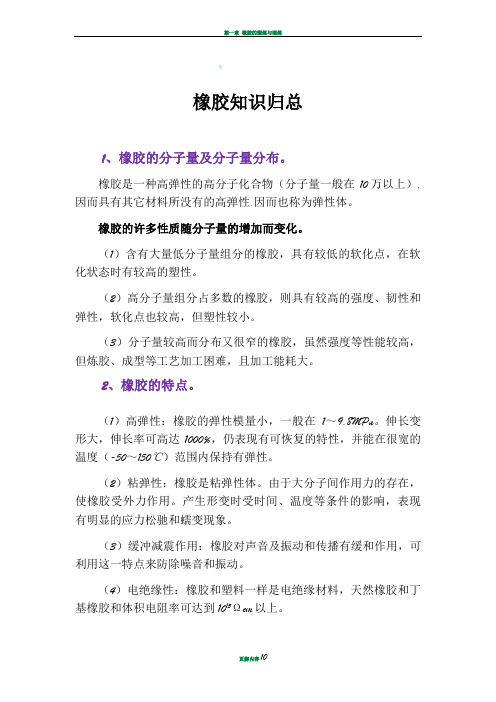
橡胶知识归总1、橡胶的分子量及分子量分布。
橡胶是一种高弹性的高分子化合物(分子量一般在10万以上),因而具有其它材料所没有的高弹性.因而也称为弹性体。
橡胶的许多性质随分子量的增加而变化。
(1)含有大量低分子量组分的橡胶,具有较低的软化点,在软化状态时有较高的塑性。
(2)高分子量组分占多数的橡胶,则具有较高的强度、韧性和弹性,软化点也较高,但塑性较小。
(3)分子量较高而分布又很窄的橡胶,虽然强度等性能较高,但炼胶、成型等工艺加工困难,且加工能耗大。
2、橡胶的特点。
(1)高弹性:橡胶的弹性模量小,一般在1~9.8MPa。
伸长变形大,伸长率可高达1000%,仍表现有可恢复的特性,并能在很宽的温度(-50~150℃)范围内保持有弹性。
(2)粘弹性:橡胶是粘弹性体。
由于大分子间作用力的存在,使橡胶受外力作用。
产生形变时受时间、温度等条件的影响,表现有明显的应力松驰和蠕变现象。
(3)缓冲减震作用:橡胶对声音及振动和传播有缓和作用,可利用这一特点来防除噪音和振动。
(4)电绝缘性:橡胶和塑料一样是电绝缘材料,天然橡胶和丁基橡胶和体积电阻率可达到1015Ωcm以上。
(5)温度依赖性:高分子材料一般都受温度影响。
橡胶在低温时处于玻璃态变硬变脆,在高温时则发生软化、熔融、热氧化、热分解以至燃烧。
(6)具有老化现象:如同金属腐蚀、木材腐朽、岩石风化一样,橡胶也会因环境条件的变化而发生老化,使性能变坏,使寿命缩短。
(7)必须硫化:橡胶必须加入硫黄或其它能使橡胶硫化(或称交联)的物质,使橡胶大分子交联成空间网状结构,才能得到具有使用价值的橡胶制品。
3、橡胶的分类。
天然橡胶丁苯橡胶SBR顺丁橡胶BR 橡胶通用合成橡胶异戊橡胶IR氯丁橡胶CR合成橡胶乙丙橡胶EPDM丁橡胶NBR特种合成橡胶硅橡胶SiR氟橡胶FPM、聚氨酯橡胶FU(1)天然橡胶(NR):成分以橡胶烃(聚异戊二烯)为主,含少量蛋白质、水分、树脂酸、糖类和无机盐等。
橡胶基础知识简介
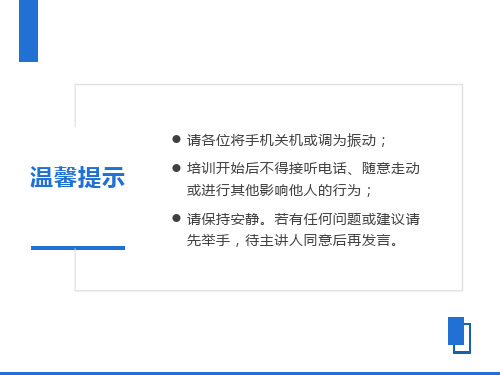
建立一流的内训体系 树立良好的企业文化氛围 打造一流的学习型企业 方正培训
气泡.发孔
原因: 硫化不足. 压力不足. 模内或胶料中有杂质或油污. 硫化模温过高. 硫化剂加少了,硫化速度太慢.
气泡.发孔的解决措施
加压 加长硫时 调整配方,加快硫化速度. 多排气. 模温不能过高. 增加硫化剂用量.
特种合成橡胶
三元乙丙胶 ( EPDM )
1
乙烯\丙烯\第三单体. 综合性能优良,用途广泛.
2
硅胶 ( SR 或Q )
3
使用温度范围最广,-120---+250℃,毒性最低.
4
氟胶 ( FKM 或 FPM )
5
防火.耐油.耐溶剂是所有胶中最好的.
6
聚氨酯 ( PU ) : 耐磨最好.
重皮.开裂
原因: 硫化速度太快,胶流动不充分. 模具脏或胶料粘污迹. 隔离剂或脱模剂太多. 胶料厚度不够.
重皮.开裂的解决措施
降低模温,减慢硫化速度. 保持胶料.模具清洁. 少用隔离剂或脱模剂. 胶料够厚.
产品脱模破裂
原因: 模温过高或者硫时过长. 硫化剂用量过多. 脱模方法不对.
产品脱模破裂
NBR7001 (单位:份数) N3350生胶 100 氧化锌 5 硬脂酸 1 防老剂RD 1 DR分散剂 1 N774碳黑 75 白碳黑 15 碳酸钙 40 DOP 12 硫磺 1.5 促进剂TT 0.5 促进剂CZ 1.5
温馨提示
请各位将手机关机或调为振动; 培训开始后不得接听电话、随意走动或进行其他影响他人的行为; 请保持安静。若有任何问题或建议请先举手,待主讲人同意后再发言。
橡胶基础知识简介
通俗定义: 橡胶是一种高弹性的高分子化合物(分子量一般在10万 以上), 具有其它材料所没有的高弹性.因而也称为弹性体. 橡胶的起源: 由热带美洲天然的哭泪树的乳液晒干凝固而成. 发展: 硫化法的发明.
橡胶的分类
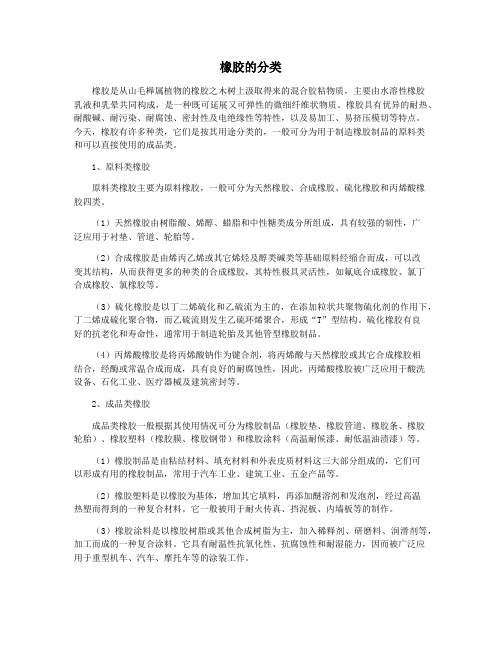
橡胶的分类橡胶是从山毛榉属植物的橡胶之木树上汲取得来的混合胶粘物质,主要由水溶性橡胶乳液和乳晕共同构成,是一种既可延展又可弹性的微细纤维状物质。
橡胶具有优异的耐热、耐酸碱、耐污染、耐腐蚀、密封性及电绝缘性等特性,以及易加工、易挤压模切等特点。
今天,橡胶有许多种类,它们是按其用途分类的,一般可分为用于制造橡胶制品的原料类和可以直接使用的成品类。
1、原料类橡胶原料类橡胶主要为原料橡胶,一般可分为天然橡胶、合成橡胶、硫化橡胶和丙烯酸橡胶四类。
(1)天然橡胶由树脂酸、烯醇、蜡脂和中性糖类成分所组成,具有较强的韧性,广泛应用于衬垫、管道、轮胎等。
(2)合成橡胶是由烯丙乙烯或其它烯烃及醇类碱类等基础原料经缩合而成,可以改变其结构,从而获得更多的种类的合成橡胶,其特性极具灵活性,如氟底合成橡胶、氯丁合成橡胶、氯橡胶等。
(3)硫化橡胶是以丁二烯硫化和乙硫流为主的,在添加粒状共聚物硫化剂的作用下,丁二烯成硫化聚合物,而乙硫流则发生乙硫环烯聚合,形成“T”型结构。
硫化橡胶有良好的抗老化和寿命性,通常用于制造轮胎及其他管型橡胶制品。
(4)丙烯酸橡胶是将丙烯酸钠作为键合剂,将丙烯酸与天然橡胶或其它合成橡胶相结合,经酶或常温合成而成,具有良好的耐腐蚀性,因此,丙烯酸橡胶被广泛应用于酸洗设备、石化工业、医疗器械及建筑密封等。
2、成品类橡胶成品类橡胶一般根据其使用情况可分为橡胶制品(橡胶垫、橡胶管道、橡胶条、橡胶轮胎)、橡胶塑料(橡胶膜、橡胶钢带)和橡胶涂料(高温耐候漆、耐低温油渍漆)等。
(1)橡胶制品是由粘结材料、填充材料和外表皮质材料这三大部分组成的,它们可以形成有用的橡胶制品,常用于汽车工业、建筑工业、五金产品等。
(2)橡胶塑料是以橡胶为基体,增加其它填料,再添加醚溶剂和发泡剂,经过高温热塑而得到的一种复合材料。
它一般被用于耐火传真、挡泥板、内墙板等的制作。
(3)橡胶涂料是以橡胶树脂或其他合成树脂为主,加入稀释剂、研磨料、润滑剂等,加工而成的一种复合涂料。
16种橡胶的化学组成性能特点及主要用途
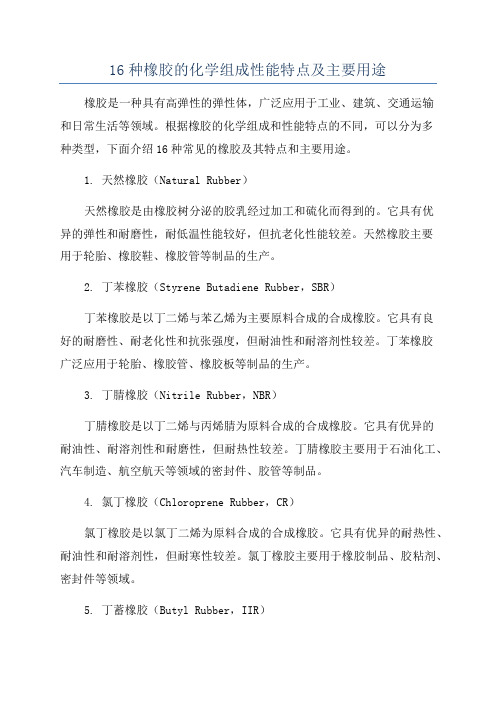
16种橡胶的化学组成性能特点及主要用途橡胶是一种具有高弹性的弹性体,广泛应用于工业、建筑、交通运输和日常生活等领域。
根据橡胶的化学组成和性能特点的不同,可以分为多种类型,下面介绍16种常见的橡胶及其特点和主要用途。
1. 天然橡胶(Natural Rubber)天然橡胶是由橡胶树分泌的胶乳经过加工和硫化而得到的。
它具有优异的弹性和耐磨性,耐低温性能较好,但抗老化性能较差。
天然橡胶主要用于轮胎、橡胶鞋、橡胶管等制品的生产。
2. 丁苯橡胶(Styrene Butadiene Rubber,SBR)丁苯橡胶是以丁二烯与苯乙烯为主要原料合成的合成橡胶。
它具有良好的耐磨性、耐老化性和抗张强度,但耐油性和耐溶剂性较差。
丁苯橡胶广泛应用于轮胎、橡胶管、橡胶板等制品的生产。
3. 丁腈橡胶(Nitrile Rubber,NBR)丁腈橡胶是以丁二烯与丙烯腈为原料合成的合成橡胶。
它具有优异的耐油性、耐溶剂性和耐磨性,但耐热性较差。
丁腈橡胶主要用于石油化工、汽车制造、航空航天等领域的密封件、胶管等制品。
4. 氯丁橡胶(Chloroprene Rubber,CR)氯丁橡胶是以氯丁二烯为原料合成的合成橡胶。
它具有优异的耐热性、耐油性和耐溶剂性,但耐寒性较差。
氯丁橡胶主要用于橡胶制品、胶粘剂、密封件等领域。
5. 丁蓄橡胶(Butyl Rubber,IIR)丁蓄橡胶是一种高度耐化学品腐蚀的合成橡胶,具有出色的气体和水蒸气阻隔性能,尤其适用于制造内胎和药品容器等密封产品。
6. 氟橡胶(Fluororubber,FKM)氟橡胶是一种耐高温、耐化学品腐蚀的合成橡胶。
它具有优异的耐热性、耐油性和耐溶剂性,广泛应用于航空航天、汽车制造等领域的密封件、橡胶制品等。
7. 聚氨酯橡胶(Polyurethane Rubber,PU)聚氨酯橡胶是一种高性能合成橡胶,具有耐磨性、耐撕裂性和抗刺穿性等优点。
它广泛应用于轮胎、液压密封件、刮板等领域。
8. 丁基橡胶(Polybutadiene Rubber,BR)丁基橡胶是一种重要的合成橡胶,具有优异的弹性、抗磨性和耐寒性。
橡胶基础知识

橡胶基础知识橡胶是一种不断发展的工程材料。
从自然橡胶发展到合成橡胶,再到高分子弹性体,橡胶的种类越来越多,应用范围也越来越广。
橡胶的定义是一种高分子化合物,具有高度的可拉伸性和可回弹性。
橡胶在应用中广泛地使用在密封、减震、气垫、橡胶软管、轮胎、橡胶地垫、橡胶管道、橡胶破碎机橡胶零件等方面。
其中,汽车轮胎、皮革、印刷墨汁、自行车胎和人造橡胶等应用最为广泛的橡胶产品。
橡胶的分类有两种,一种是天然橡胶,另一种是合成橡胶。
天然橡胶是由橡胶树中的乳液提取而来,是一种高分子有机成分,其中又包含了约98%的高分子碳水化合物及少量的蛋白质、油脂和灰分。
而合成橡胶则是通过人工合成的高分子化合物,具有与天然橡胶相似的性质,但是比天然橡胶优良的特性是合成橡胶的种类和特性更灵活,可以根据需要进行改良和提高,不仅能适用于不同的业务领域,而且具有更广泛的市场需求。
关于橡胶的物理性质,其品质与物水的机械性能、耐热性和抗老化性能有关。
而橡胶的化学性能则和各类有机溶剂、硝酸、氢氧化物等有关。
一般来说,橡胶的耐候性能、抗紫外线、抗氧化、抗臭氧、耐酸碱性较大程度上取决于其化学构成,这个特性对长期使用的橡胶制品具有非常重要的意义。
橡胶由于其高分子化学构成,具有许多特殊性质,如在变形时可以恢复原来的形状,也可以随变形而变形,在机械应力作用下表现出接近弹性的性质。
橡胶还具有非常高的抗寒性,因为在低温下还可以保持较大的伸长量。
此外,橡胶也具有耐化学腐蚀和耐高温性的特点,使得他们在航空、飞行器和汽车等领域得到了广泛的应用。
关于橡胶的加工过程,橡胶一般不适用于单独作为材料来应用,需要经过一定的加工过程后才能使用到它的全部优良特性。
橡胶加工主要包括几个过程,如混炼、成型、硫化和后处理等。
其中混炼是指将橡胶与其他添加剂(如填料和增塑剂)混合在一起,使之成为胶体。
橡胶经过混炼之后,可以被用于成型,如挤出成型、压缩成型、注射成型等,使之成为所需要的产品,而硫化过程则是将成型后的橡胶制品加热,在硫化质量控制下使其形成三维网络结构,这个过程使得橡胶制品具有出色的耐用性和抗热性。
橡胶的基本知识
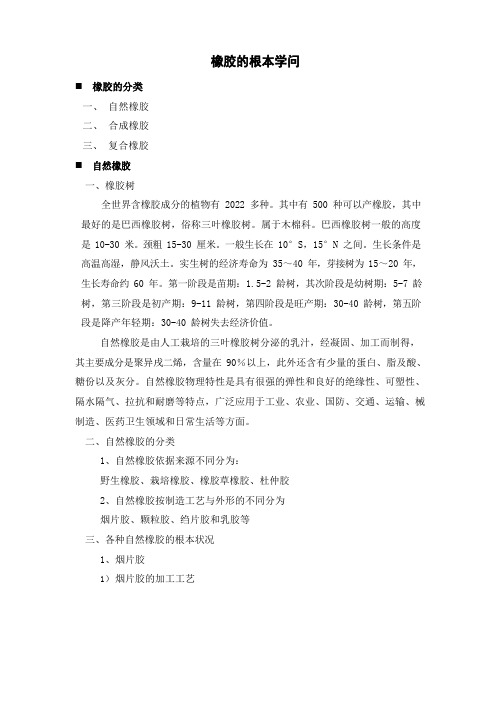
橡胶的根本学问⏹橡胶的分类一、自然橡胶二、合成橡胶三、复合橡胶⏹自然橡胶一、橡胶树全世界含橡胶成分的植物有 2022 多种。
其中有 500 种可以产橡胶,其中最好的是巴西橡胶树,俗称三叶橡胶树。
属于木棉科。
巴西橡胶树一般的高度是 10-30 米。
颈粗 15-30 厘米。
一般生长在10°S,15°N之间。
生长条件是高温高湿,静风沃土。
实生树的经济寿命为 35~40 年,芽接树为 15~20 年,生长寿命约 60 年。
第一阶段是苗期:1.5-2 龄树,其次阶段是幼树期:5-7 龄树,第三阶段是初产期:9-11 龄树,第四阶段是旺产期:30-40 龄树,第五阶段是降产年轻期:30-40 龄树失去经济价值。
自然橡胶是由人工栽培的三叶橡胶树分泌的乳汁,经凝固、加工而制得,其主要成分是聚异戌二烯,含量在 90%以上,此外还含有少量的蛋白、脂及酸、糖份以及灰分。
自然橡胶物理特性是具有很强的弹性和良好的绝缘性、可塑性、隔水隔气、拉抗和耐磨等特点,广泛应用于工业、农业、国防、交通、运输、械制造、医药卫生领域和日常生活等方面。
二、自然橡胶的分类1、自然橡胶依据来源不同分为:野生橡胶、栽培橡胶、橡胶草橡胶、杜仲胶2、自然橡胶按制造工艺与外形的不同分为烟片胶、颗粒胶、绉片胶和乳胶等三、各种自然橡胶的根本状况1、烟片胶1)烟片胶的加工工艺35%胶乳→过滤去杂质→加水稀释至15~20%→消泡澄清滤渣→加 1%甲酸凝固〔或乙酸〕→除水→压 3~3.5mm 薄片→薰烟枯燥〔70℃,7~8 天,防止霉变〕→检查分级包装2)R SS:分为 1,2,3,4,5.还有特级。
烟片胶是成片包装的,颜色为黄色,最好的是金黄色。
它可以通过目测色泽指数来推断级别。
3)3号烟片胶为胶包原包装,件重为 111.11kg,每吨9包。
主要的生产国:泰国,印度,(RSS3,RSS4.印度的烟片胶质量不好,一般只用来做复合胶的生产。
)印尼〔印尼的烟片只在国有农场生产,量很少。
橡胶选材知识点总结大全
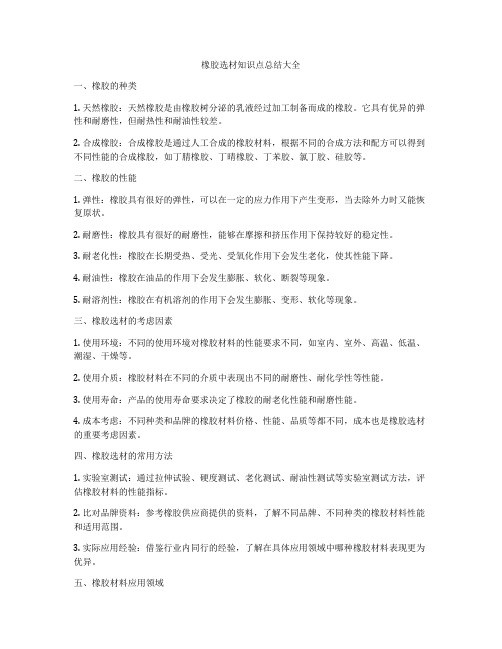
橡胶选材知识点总结大全一、橡胶的种类1. 天然橡胶:天然橡胶是由橡胶树分泌的乳液经过加工制备而成的橡胶。
它具有优异的弹性和耐磨性,但耐热性和耐油性较差。
2. 合成橡胶:合成橡胶是通过人工合成的橡胶材料,根据不同的合成方法和配方可以得到不同性能的合成橡胶,如丁腈橡胶、丁晴橡胶、丁苯胶、氯丁胶、硅胶等。
二、橡胶的性能1. 弹性:橡胶具有很好的弹性,可以在一定的应力作用下产生变形,当去除外力时又能恢复原状。
2. 耐磨性:橡胶具有很好的耐磨性,能够在摩擦和挤压作用下保持较好的稳定性。
3. 耐老化性:橡胶在长期受热、受光、受氧化作用下会发生老化,使其性能下降。
4. 耐油性:橡胶在油品的作用下会发生膨胀、软化、断裂等现象。
5. 耐溶剂性:橡胶在有机溶剂的作用下会发生膨胀、变形、软化等现象。
三、橡胶选材的考虑因素1. 使用环境:不同的使用环境对橡胶材料的性能要求不同,如室内、室外、高温、低温、潮湿、干燥等。
2. 使用介质:橡胶材料在不同的介质中表现出不同的耐磨性、耐化学性等性能。
3. 使用寿命:产品的使用寿命要求决定了橡胶的耐老化性能和耐磨性能。
4. 成本考虑:不同种类和品牌的橡胶材料价格、性能、品质等都不同,成本也是橡胶选材的重要考虑因素。
四、橡胶选材的常用方法1. 实验室测试:通过拉伸试验、硬度测试、老化测试、耐油性测试等实验室测试方法,评估橡胶材料的性能指标。
2. 比对品牌资料:参考橡胶供应商提供的资料,了解不同品牌、不同种类的橡胶材料性能和适用范围。
3. 实际应用经验:借鉴行业内同行的经验,了解在具体应用领域中哪种橡胶材料表现更为优异。
五、橡胶材料应用领域1. 工程机械:橡胶轮胎、橡胶履带、橡胶密封件等是工程机械中常见的橡胶材料应用。
2. 汽车制造:汽车轮胎、汽车密封件、汽车减震器等都是橡胶材料的重要应用领域。
3. 食品加工:橡胶输送带、橡胶密封圈等在食品加工行业中广泛应用。
4. 医疗器械:医用橡胶手套、医用橡胶管等都是医疗器械中必不可少的橡胶材料。
实用橡胶手册

实用橡胶手册橡胶是一种广泛应用于各种领域的重要材料。
它具有良好的弹性、耐磨损、耐化学腐蚀等特性,因此在汽车、电子、建筑、医疗等行业中得到广泛应用。
为了帮助人们更好地了解和使用橡胶制品,本手册为您介绍橡胶的基本知识、分类、性能、应用以及维护保养等方面内容。
一、橡胶的基本知识1.橡胶的定义:橡胶是一种可以通过硫化制得弹性固体的高分子化合物,它是由天然橡胶或合成橡胶通过加工制成的。
2.橡胶的起源:天然橡胶主要来自于橡胶树的乳液,它的主要成分是聚合体异戊二烯。
合成橡胶则是通过人工合成,常见的有丁苯橡胶、丁腈橡胶、丁晴橡胶等。
3.橡胶的加工:橡胶加工主要包括混炼、成型和硫化三个过程。
混炼是将橡胶与各种添加剂进行均匀混合;成型是按照需要将混炼好的橡胶制成各种形状;硫化是通过加热使橡胶产生硫化反应,使其具有弹性和耐用性。
二、橡胶的分类根据其成分和性能的不同,橡胶可以分为天然橡胶和合成橡胶两大类。
1.天然橡胶:主要来自于橡胶树的乳液,经过提纯和处理后得到。
它具有高弹性、高韧性和高可拉伸性等特点,适用于制作弹性元件和各种橡胶制品。
2.合成橡胶:通过人工合成的橡胶,根据其成分可以分为丁苯橡胶、丁腈橡胶、丁晴橡胶等。
合成橡胶具有化学稳定性好、工艺性好、耐磨性强等特点,适用于制作各种耐磨、耐化学腐蚀的橡胶制品。
三、橡胶的性能橡胶具有以下主要性能:1.弹性:橡胶具有优异的弹性,能够在外力作用下迅速恢复原状,这使得橡胶成为理想的密封和减震材料。
2.耐磨性:橡胶具有良好的耐磨性,能够在摩擦和磨损条件下长时间保持良好的使用性能。
3.耐化学腐蚀性:橡胶具有优异的化学稳定性,能够耐受酸碱腐蚀和许多溶剂的侵蚀。
4.密封性:橡胶具有良好的密封性能,可以有效防止气体和液体的泄漏。
5.耐高温性:一些特殊的橡胶制品具有耐高温性能,能够在高温环境下正常使用。
四、橡胶的应用橡胶广泛应用于各个行业,下面为您介绍几个常见的应用领域:1.汽车行业:橡胶用于制造汽车轮胎、密封件、减震器等,它的弹性和耐磨性能使得汽车在行驶过程中更加平稳和安全。
橡胶 成分
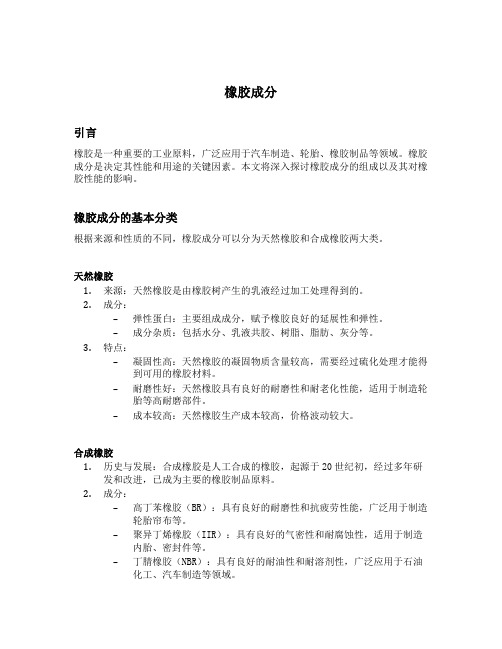
橡胶成分引言橡胶是一种重要的工业原料,广泛应用于汽车制造、轮胎、橡胶制品等领域。
橡胶成分是决定其性能和用途的关键因素。
本文将深入探讨橡胶成分的组成以及其对橡胶性能的影响。
橡胶成分的基本分类根据来源和性质的不同,橡胶成分可以分为天然橡胶和合成橡胶两大类。
天然橡胶1.来源:天然橡胶是由橡胶树产生的乳液经过加工处理得到的。
2.成分:–弹性蛋白:主要组成成分,赋予橡胶良好的延展性和弹性。
–成分杂质:包括水分、乳液共胶、树脂、脂肪、灰分等。
3.特点:–凝固性高:天然橡胶的凝固物质含量较高,需要经过硫化处理才能得到可用的橡胶材料。
–耐磨性好:天然橡胶具有良好的耐磨性和耐老化性能,适用于制造轮胎等高耐磨部件。
–成本较高:天然橡胶生产成本较高,价格波动较大。
合成橡胶1.历史与发展:合成橡胶是人工合成的橡胶,起源于20世纪初,经过多年研发和改进,已成为主要的橡胶制品原料。
2.成分:–高丁苯橡胶(BR):具有良好的耐磨性和抗疲劳性能,广泛用于制造轮胎帘布等。
–聚异丁烯橡胶(IIR):具有良好的气密性和耐腐蚀性,适用于制造内胎、密封件等。
–丁腈橡胶(NBR):具有良好的耐油性和耐溶剂性,广泛应用于石油化工、汽车制造等领域。
–丁苯橡胶(SBR):具有良好的耐磨性和弹性,是制造轮胎的主要材料。
3.特点:–物理性能可调:合成橡胶的配方可以根据需要进行调整,以达到不同的物理和化学性能要求。
–成本相对较低:相比天然橡胶,合成橡胶的生产成本较低,稳定性和供应量也更可靠。
橡胶成分与性能的关系橡胶成分的组成对于橡胶材料的物理、化学和机械性能有着重要影响。
物理性能1.弹性:橡胶的弹性主要依赖于其中的弹性蛋白,天然橡胶由于其特殊的成分组成,具有较高的弹性。
2.延展性:弹性蛋白和一定数量的软化剂可以提高橡胶的延展性,而填料和交联剂等会降低其延展性。
3.密度:橡胶成分中不同物质的密度差异会影响橡胶的密度。
化学性能1.耐溶剂性:合成橡胶的成分中通常含有一定的亲溶剂基团,使其具有较好的耐溶剂性。
- 1、下载文档前请自行甄别文档内容的完整性,平台不提供额外的编辑、内容补充、找答案等附加服务。
- 2、"仅部分预览"的文档,不可在线预览部分如存在完整性等问题,可反馈申请退款(可完整预览的文档不适用该条件!)。
- 3、如文档侵犯您的权益,请联系客服反馈,我们会尽快为您处理(人工客服工作时间:9:00-18:30)。
SVENSK STANDARDSS-ISO 4650:2005Fastställd 2005-10-07Utgåva 2ICS 83.060Språk: engelskaPublicerad: november 2005Gummi – Identifikation – IR-spektrometermetod(ISO 4650:2005, IDT)Rubber – Identification – Infrared spectrometricmethod (ISO 4650:2005, IDT)Den internationella standarden ISO 4650:2005 gäller som svensk standard. Detta dokument innehåller den officiella engelska versionen av ISO 4650:2005.Denna standard ersätter SS-ISO 4650, utgåva 1.The International Standard ISO 4650:2005 has the status of a Swedish Standard. This document contains the official English version of ISO 4650:2005.This standard supersedes the Swedish Standard SS-ISO 4650, edition 1.Upplysningar om sakinnehållet i standarden lämnas av SIS, Swedish Standards Institute,telefon 08 - 555 520 00.Standarder kan beställas hos SIS Förlag AB som även lämnar allmänna upplysningar om svensk ochutländsk standard.Postadress: SIS Förlag AB, 118 80 STOCKHOLMTelefon: 08 - 555 523 10. Telefax: 08 - 555 523 11SS-ISO 4650:2005Contents PageForeword (v)1Scope (1)2Normative references (1)3Principle (1)4Types of rubber (1)4.1General (1)4.2Exceptions for blends (3)4.3Reference spectra (3)5Reagents (3)6Apparatus (4)7Procedure (5)7.1Procedure for raw rubber films moulded or cast from solution (5)7.2Procedure for raw rubbers, vulcanizates and films obtained from pyrolysate (5)7.3Procedure for vulcanized rubber film obtained after evaporation of the solution solvent (6)8Interpretation of spectra (7)8.1Reference spectra (7)8.2Tables of diagnostic absorptions (8)9Test report (8)Annex A (informative) Absorption characteristics and reference spectra (9)Table A.1 — Types of rubber and corresponding reference spectra (10)Table A.2 — Acrylic rubber (ACM) (11)Table A.3 — Chloropolyethylene (CM) (12)Table A.4 — Chlorosulfonylpolyethylene (CSM) (13)Table A.6 — Fluorocarbon rubber (FKM) (15)Table A.7 — Polychloromethyloxirane (CO) (16)Table A.8 — Copolymer of ethylene oxide and chloromethyloxirane (ECO) (17)Table A.9 — Polydimethylsiloxane (MQ) (18)Table A.10 — Butadiene rubber (BR) (19)Table A.11 — Chloroprene rubber (CR) (21)Table A.12 — Isobutene-isoprene rubber (IIR) (22)Table A.13 — Bromo-isobutene-isoprene rubber (BIIR) (23)Table A.14 — Natural rubber (NR) (24)Table A.15 — Isoprene rubber (IR) (25)Table A.16 — Acrylonitrile-butadiene rubber (NBR) (27)Table A.17 — Hydrogenated acrylonitrile-butadiene rubber (HNBR) (28)Table A.18 — Carboxylic-acrylonitrile-butadiene rubber (XNBR) (29)Table A.19 — Styrene butadiene rubber (SBR) (30)SS-ISO 4650:2005Table A.21 — Block copolymer of styrene and butadiene (TPS-SBS) (34)Table A.22 — Polystyrene-poly(ethylene-butylene)-polystyrene (TPS-SEBS) (35)Table A.23 — Block copolymer of styrene and isoprene (TPS-SIS) (36)Table A.24 — Polystyrene-poly(ethylene-propylene)-polystyrene (TPS-SEPS) (37)Table A.25 — Syndiotactic poly(1,2-butadiene) (TPZ) (38)Table A.26 — Copolyester TPE with a soft segment with ester and ether linkages (TPC-EE) (39)Bibliography (40)ForewordISO (the International Organization for Standardization) is a worldwide federation of national standards bodies (ISO member bodies). The work of preparing International Standards is normally carried out through ISO technical committees. Each member body interested in a subject for which a technical committee has been established has the right to be represented on that committee. International organizations, governmental and non-governmental, in liaison with ISO, also take part in the work. ISO collaborates closely with the International Electrotechnical Commission (IEC) on all matters of electrotechnical standardization.International Standards are drafted in accordance with the rules given in the ISO/IEC Directives, Part 2.The main task of technical committees is to prepare International Standards. Draft International Standards adopted by the technical committees are circulated to the member bodies for voting. Publication as an International Standard requires approval by at least 75 % of the member bodies casting a vote.Attention is drawn to the possibility that some of the elements of this document may be the subject of patent rights. ISO shall not be held responsible for identifying any or all such patent rights.ISO 4650 was prepared by Technical Committee ISO/TC 45, Rubber and rubber products, Subcommittee SC 2, Testing and analysis.This second edition cancels and replaces the first edition (ISO 4650:1984), which has been technically revised.Rubber — Identification — Infrared spectrometric method1 ScopeThis International Standard specifies a method for the identification of rubbers, including thermoplastic elastomers, either in the raw state or in the form of vulcanized or unvulcanized mixes. The method is based on infrared spectrometric examination using the transmission technique.The method comprises examination of polymers by their pyrolysis products (pyrolysates), or by films cast from solution or obtained by moulding (for raw rubbers only).Typical spectra are given in Annex A.The principle of the method implies that sample preparation and analysis of the infrared spectra are carried out by experienced personnel and that the equipment used for the production of spectra is operated in accordance with the manufacturer's instructions for optimum performance. Details of the operation of infrared spectrometers are not included in this International Standard.The method specified is a qualitative method only.2 Normative referencesThe following referenced documents are indispensable for the application of this document. For dated references, only the edition cited applies. For undated references, the latest edition of the referenced document (including any amendments) applies.ISO 1407, Rubber — Determination of solvent extractISO 18064, Thermoplastic elastomers — Nomenclature and abbreviated terms3 PrincipleThe extractable material is first extracted from a test sample of the rubber and the rubber then prepared under precise conditions for spectroscopy in the form of raw polymer film, vulcanizate pyrolysate or vulcanizate film. The IR spectrum is recorded and then interpreted by comparison with a set of typical reference spectra. 4 Types of rubber4.1 GeneralThe method is applicable to rubbers in the raw state and, if compounded, in both the vulcanized and unvulcanized states. It is applicable to the following types of rubber occurring either alone or in a binary mixture when the proportion of the minor component is, in general, not less than 10 % to 20 % by mass of the mixture (see, however, exceptions in 4.2).4.1.1 M group4.1.1.1 Acrylic rubber (ACM): Copolymer of ethyl acrylate (or other acrylates) and a small amount of a monomer which facilitates vulcanization.4.1.1.2 Chloropolyethylene (CM) and chlorosulfonylpolyethylene (CSM): The method will not differentiate CM from CSM, and it will not differentiate between different types of CSM.4.1.1.3Ethylene-propylene copolymer (EP M) and ethylene-propylene-diene terpolymer (EP DM):The method will not differentiate between the two types of polymer. However, examination of the spectrum gives some information about the ethylene-to-propylene ratio.4.1.1.4Fluorocarbon rubber (FKM): Examination of the pyrolysate may give some information about the different grades of fluorocarbon rubber present.4.1.2 O group4.1.2.1P olychloromethyloxirane (CO): Copolymer of ethylene oxide and chloromethyloxirane (ECO) and terpolymers. Examination of the pyrolysate will not differentiate between different types of CO.4.1.3 Q group 4.1.3.1 P olydimethylsiloxane (MQ), polymethylphenylsiloxane (PMQ) and polymethyl-fluorosiloxane (FMQ): Examination of the pyrolysate will differentiate PMQ from MQ.4.1.4 R group4.1.4.1 Butadiene rubber (BR): Examination of the pyrolysate will not differentiate between butadiene rubbers having different isomer ratios. However, examination of a raw rubber film gives some information about the isomer ratio.4.1.4.2 Chloroprene rubber (CR): The method will not differentiate between the different types of CR.4.1.4.3 Isobutene-isoprene rubber (IIR) and halogenated isobutene-isoprene rubbers (BIIR and CIIR): Under the conditions used for the method, it is not possible to differentiate between IIR, BIIR, CIIR and polyisobutene.4.1.4.4 Natural rubber (NR) and synthetic isoprene rubber (IR): Natural rubber (1,4-cis -polyisoprene), gutta percha, balata (1,4-trans -polyisoprene) and synthetic isoprene rubber, whatever their microstructure, (1,4-cis , 1,4-trans or 3,4-) are included.4.1.4.4.1 Examination of a rubber film will differentiate between 1,4-cis , 1,4-trans and 3,4-polyisoprenes; for non-extracted rubbers, it will differentiate natural rubber from 1,4-cis synthetic isoprene rubber, and 1,4-trans natural polyisoprenes from their synthetic counterparts. Examination of the pyrolysate film obtained from a vulcanizate provides no information on the microstructure of the polyisoprene or its origin, whether natural or synthetic.4.1.4.5 Acrylonitrile-butadiene rubber (NBR): The method will differentiate carboxylic acrylonitrile-butadiene rubbers (XNBRs) from hydrogenated acrylonitrile-butadiene rubbers (HNBRs). Associations of butadiene copolymers and PVC are included. Examination of the pyrolysate film gives some information about the acrylonitrile content.4.1.4.6 Styrene-butadiene rubber (SBR): The method will differentiate D -methylstyrene-butadiene rubbers from styrene-butadiene rubbers. Copolymers of styrene and butadiene, as well as of their substituted derivatives (e.g. D -methylstyrene), are included. Examination of a pyrolysate will not differentiate emulsion-polymerized rubbers from solution-polymerized rubbers. However, examination of a spectrum gives some information about the monomer ratio.SS-ISO 4650:20054.1.4.7P olynorbornene.4.1.5 T group4.1.5.1P olysulfiderubbers.4.1.6 U group4.1.6.1 P olyester urethane (AU) and polyether urethane (EU): The method covers only millable polyurethanes.4.1.7 TP E group4.1.7.1 As defined in ISO 18064.4.2 Exceptions for blends4.2.1 Analysis of a blend of ethylene-propylene rubber with other rubbers presents difficulties when its ethylene-propylene content is below 40 %.4.2.2 The method will not differentiate between blends of ethylene-propylene rubber with chlorinated polyethylene and/or chloro-sulfonated polyethylene.4.2.3 Analysis of a blend of natural and/or synthetic polyisoprene and chloroprene rubber may present difficulties, and identification of the minor component may only be possible when the content is equal to or greater than 30 % in the blend.4.2.4 The method will not differentiate NBR from NBR/BR blends or NBR blends, nor will it differentiate SBR from SBR/BR blends or SBR blends.4.2.5 The presence of high quantities of sulfur in a vulcanizate may affect some characteristic bands.4.2.6 The method will not differentiate NBR/PVC blends from blends of NBR with other halogenated polymers or additives.4.3 Reference spectraTables of absorption characteristics and reference spectra from 4 000 cm–1 to 600 cm–1 for typical rubbers are given in Annex A.5 Reagents5.1 Nitrogen, in pressurized cylinders.5.2 Extraction solvents, chosen to achieve maximum extraction (alternative solvents may be used on condition that it can be shown that they do not interfere with the interpretation of the infrared spectrum):5.2.1 Methanol.5.2.2 Acetone.5.3 Solvents for rubber dissolution and film preparation, water-free and free from residues (see ISO 1407):5.3.1 Chloroform.SS-ISO 4650:20055.3.2 1,2-dichlorobenzene.5.4 Sodiumsulfate, anhydrous.5.5 Universal pH-indicator paper.6 Apparatus6.1 Extractionapparatus.The apparatus specified in ISO 1407 is satisfactory.6.2P yrolysis apparatus (see Figure 1), comprising a glass tube A having inward projections to preventthe sample from falling to the bottom of the tube, and a lateral condenser tube. The tube A has a standard ground-glass joint B that carries a small glass adductor tube. A collecting tube C is placed under the condenser tube. A thermoregulated electric furnace D accommodates an aluminium block E with holes for oneor more tubes A.KeyA glass tube for sampleB ground-glassjointC collectingtubeD thermoregulated electric furnaceE aluminium block, bored to hold tubesF thermocoupleFigure 1 — Temperature-controlled pyrolysis apparatusSS-ISO 4650:20056.3 Capillarypipettes.6.4 Oven, capable of being maintained at 200 °C r 5 °C.6.5 Waterbath.6.6 Polished potassium bromide salt plates.6.7 Filteraid, e.g. diatomaceous earth or similar.6.8 Infrared spectrometer, of either the Fourier transform or dispersive type, with a wavenumber range of 4 000 cm–1 to 600 cm 1 and a spectral resolution of 4 cm–1 or higher.7P rocedure7.1 Procedure for raw rubber films moulded or cast from solution7.1.1 Using a suitable solvent (see 5.2), extract the extractable material from a test sample of 2 g to 5 g in accordance with the procedure given in ISO 1407.7.1.2 Dissolve a sufficient amount of the extracted rubber in a suitable solvent (see 5.3), at room temperature or under reflux, to give a concentrated solution.7.1.3 Place a few drops of the concentrated solution on a potassium bromide salt plate (6.6) and allow the solvent to evaporate.7.1.4 Films of raw rubber of a suitable thickness may also be obtained by moulding.7.1.5 Record the spectrum from 4 000 cm–1 to 600 cm–1 using the infrared spectrometer (6.8).7.1.6 After recording the spectrum, verify that no solvent absorption bands are present and check that the bands of the spectrum are neither off-scale nor too low. If these conditions are not met, repeat the preparation procedure on a fresh test sample and record a new spectrum.7.1.7 A test for halogens may be carried out as described in 7.2.1.4.7.2 Procedure for raw rubbers, vulcanizates and films obtained from pyrolysateNOTE The methods described in 7.2.1 and 7.2.2 may give different relative absorbances for the polymers in a given blend.7.2.1 Preferred method: Temperature-controlled pyrolysis in a stream of nitrogen7.2.1.1 Extract a 2 g to 5 g test sample in accordance with the procedure given in ISO 1407.7.2.1.2 Depending on the nature of the composition of the unknown vulcanizate and of the type of apparatus used, place 0,5 g to 2 g of the extracted, dried test sample in the pyrolysis tube A (see Figure 1).7.2.1.3 Introduce a small quantity of sodium sulfate in the collector tube C to absorb water formed in the pyrolysis.7.2.1.4 Carry out a test for halogen, for instance by placing a strip of moistened indicator paper (5.5) across the mouth of the collecting tube. An acid colour, pH 1 to pH 2, indicates the presence of halogen. Residues of halogenated additives present in the vulcanizate may cause interference. Other suitable halogen-detection methods may also be used.SS-ISO 4650:20057.2.1.5 Bring the electric furnace D to 525 °C r50 °C and hold within this temperature range. This temperature range is recommended to obtain rapid pyrolysis without excessive degradation or carbonization.A temperature of 475 °C is advised, however, to obtain the maximum quantity of pyrolysate for NR, IR, BR, SBR, IIR, BIIR and CIIR.7.2.1.6 Pass a slow stream of nitrogen (5.1) through the pyrolysis tube A and introduce the tube containing the prepared test sample into a hole in the aluminium block E. Nitrogen serves to displace air, prevent oxidation and facilitate transfer of the pyrolysis products into the collecting tube C. Maintain the nitrogen flow at 10 cm3/min r 2 cm3/min.7.2.1.7 Continue the heating to complete distillation, i.e. for about 15 min.7.2.1.8 Place a few drops of the homogenized pyrolysate between two potassium bromide salt plates and mount the cell in the infrared spectrometer. Run the spectrum immediately after pyrolysis to avoid oxidation. 7.2.1.9 Record the infrared spectrum from 4 000 cm–1 to 600 cm–1, performing the same checks as described in 7.1.6.7.2.2 Alternative method: Gas flame pyrolysis7.2.2.1 Rapid pyrolysis may be performed in a test tube in place of the procedures described in 7.2.1.2, 7.2.1.3, 7.2.1.5, 7.2.1.6 and 7.2.1.7.7.3 Procedure for vulcanized rubber film obtained after evaporation of the solution solvent NOTE The methods described in 7.3.1 and 7.3.2 may give different relative absorbances for the polymers in a given blend. The films obtained by the method described in 7.3.2 may contain a higher proportion of the thermally less stable polymer.7.3.1 Dissolution of vulcanizate7.3.1.1 Prepare a test sample of about 2 g (or 6 g if the presence of chloroprene rubber is suspected) (see 7.3.1.2 and 7.3.1.3) and proceed with the extraction as described in ISO 1407.7.3.1.2 Pyrolyse approximately 1 g of the prepared test sample and carry out a halogen test as described in 7.2.1.4.7.3.1.3 If no chloroprene rubber is present, place 1 g of the test sample prepared in 7.3.1.1 and 50 cm3 ofa solvent appropriate to the rubber type (see 5.3) (1,2-dichlorobenzene is suggested) in a 100 cm3 flask fitted with a reflux condenser. If chloroprene rubber is present, place approximately 5 g of the test sample prepared in 7.3.1.1 with 200 cm3 of solvent in a 500 cm3 flask fitted with a reflux condenser.Heat the contents until the test sample has dissolved.The time required for adequate dissolution varies depending on the rubber, e.g. 3 h to 4 h for NR; 12 h for CR. To reduce the risk of altering the molecular structure of the rubber, do not exceed 12 h heating.7.3.1.4 If the rubber does not contain carbon black, centrifuge to eliminate mineral fillers.7.3.1.5 If the rubber contains carbon black, add 10 g to 20 g of filter aid (6.7) and filter through filter paper. Should the filtrate contain carbon black, repeat the filtration with more filter aid.NOTE Acrylonitrile-butadiene rubber (NBR) may be retained on the filter paper.7.3.1.6 Concentrate the centrifuged or filtered solution to a small volume under a stream of nitrogen (5.1) or reduced pressure.7.3.1.7 Evaporate a few drops of the concentrated solution on a potassium bromide salt plate.7.3.1.8 Record the infrared spectrum from 4 000 cm–1 to 600 cm–1, performing the same checks as described in 7.1.6.7.3.2 Mild thermal degradation of vulcanizates7.3.2.1 This technique shall not be used on blends which may contain chloroprene rubber.7.3.2.2 Prepare a test sample of 2 g as described in 7.2.1.17.3.2.3 Place the prepared test sample in a test tube capped with glass wool and heat for about 10 min in an oven (6.4) regulated at 200 °C r 5 °C (a temperature of 180 °C is advised for NR, IR, BR, SBR, IIR, BIIR and CIIR rubbers).7.3.2.4 Allow the test sample to cool, transfer to a 100 cm3 flask fitted with a reflux condenser and add 50 cm3 of chloroform (5.3.1) to the flask. Place the flask in a hot water bath.7.3.2.5 Allow the flask and contents to remain for about 30 min in the water bath, with the solvent refluxing, to dissolve the degraded rubber.7.3.2.6 Filter the mixture obtained in 7.3.2.5 through filter paper to remove any undissolved vulcanizate and fillers. Should carbon black be released from the vulcanizate, add a small amount of filter aid (6.7) to the solution before filtering.7.3.2.7 When it is suspected that the filtrate obtained in 7.3.2.6 contains material other than rubber which might interfere in the interpretation of the final spectrum, precipitate the polymer from the filtrate obtained in 7.3.2.6 using methanol. Filter off the recovered polymer and redissolve it in chloroform (5.3.1).7.3.2.8 Evaporate a few drops of the chloroform solution on a potassium bromide salt plate (6.6) to give a film thickness suitable for the production of an analytical spectrum.7.3.2.9 Record the spectrum from 4 000 cm–1 to 600 cm–1, performing the same checks as described in7.1.6.8 Interpretation of spectra8.1 Reference spectra8.1.1 Due to the existence of different spectral presentation modes, it may be necessary to prepare a set of reference spectra on the same infrared spectrometer as is used to analyse the unknown samples.8.1.2 Reference spectra shall be produced from test samples of known composition, following the procedure used for unknown samples.8.1.3 Spectra of mixtures are not given in Annex A because of the multiplicity of polymer combinations and proportions. Each laboratory should prepare its own set from test samples of known composition.8.1.4 Small, but unavoidable, variations in experimental conditions and instrument characteristics may give rise to slight differences in spectra. Spectra produced at different times may not be identical in terms of peak height and absorbance.8.1.5 In all cases, spectra shall be interpreted bearing in mind the result of the test for halogen.8.1.6 The comparison between test spectra and reference spectra shall take into account the wavenumbers of the bands, how many bands are present, their relative intensity and their form. Any unexpected bands shall also be interpreted. It is essential that all the bands be examined, irrespective of their number.8.2 Tables of diagnostic absorptions8.2.1 The tables of diagnostic absorption bands given in Annex A shall be used only in conjunction with reference spectra. Their purpose is to indicate the principal absorption bands.8.2.2 The tables complement the reference spectra by drawing attention to absorption bands which are absent, permitting the elimination of certain rubbers when ambiguity could otherwise arise.8.2.3 Diagnostic absorption bands are classified by increasing wavenumber. A diagnostic absorption band is one whose features are recognized by an experienced analyst as being of significance in rubber identification. These features, associated with certain compositional or structural characteristics of the pyrolysates and films, are reproducible in the sense that they are not seriously influenced by moderate variations in the conditions of pyrolysis or of dissolution.9 Test reportThe test report shall include the following particulars:a) a reference to this International Standard;b) all details required for the complete identification of the sample;c) the method used;d) identification of the rubber(s) in the sample;e) the date of the test.Annex A(informative)Absorption characteristics and reference spectraA.1 GeneralA.1.1This annex provides tables of absorption characteristics and figures showing reference spectra for pyrolysates and films.A.1.2 Comparisons between sample spectra and reference spectra will have to take into account the position of the bands, how many there are, their relative intensity and their shape.A.1.3 It is essential that all the bands in a spectrum be examined, with no restrictions on the zone which is searched for characteristic bands.A.2 Tables of absorption characteristics and figures showing reference spectraA.2.1 In order to ease the task of the user of this International Standard, the scale chosen for the presentation of the spectra is designed to show clearly the specific absorption bands.A.2.2 Table A.1 indicates which figures correspond to the reference spectra for which types of rubber.Table A.1 — Types of rubber and corresponding reference spectraFigure numberTable number Symbol for rubberType of rubberRaw polymer film VulcanizatepyrolysateM groupA.2A.3A.4A.5A.6ACM CM CSM EPDM FKMAcrylic rubber Chloropolyethylene ChlorosulfonylpolyethyleneEthylene-propylene-diene terpolymer Fluorocarbon rubberA.1A.3A.5A.7A.9A.2A.4A.6A.8A.10O groupA.7A.8CO ECOPolychloromethyloxiraneCopolymer of ethylene oxide and chloromethyloxiraneA.11A.13A.12Q groupA.9 MQ Polydimethylsiloxane A.14 A.15R groupA.10A.11A.12A.13A.14A.15A.16A.17A.18A.19A.20BRCR IIR BIIR NR IRNBR HNBR XNBR SBR E-SBRS-SBRHSBRButadiene rubber high-cis BR high-trans BR low-cis BRChloroprene rubber Isobutene-isoprene rubber Bromo-isobutene-isoprene rubber Natural rubberSynthetic isoprene rubber high-cis IR high-trans IRAcrylonitrile-butadiene rubberHydrogenated acrylonitrile-butadiene rubber Carboxylic-acrylonitrile-butadiene rubber Styrene-butadiene rubber Emulsion-polymerized SBR23,5 % styrene E-SBEhigh-styrene E-SBE Solution-polymerized SBR high-vinyl S-SBR high-styrene S-SBRHydrogenated styrene-butadiene rubberA.16A.18A.19A.20A.22A.24A.26A.28A.30A.32A.34A.36A.37A.39A.40A.41A.42A.17A.21A.23A.25A.27A.29A.31A.33A.35A.38TFE groupA.21A.22A.23A.24A.25A.26TPS-SBS TPS-SEBS TPS-SIS TPS-SEPS TPZ TPC-EEBlock copolymer of styrene and butadiene Polystyrene-poly(ethylene-butylene)-polystyrene Block copolymer of styrene and isoprene Polystyrene-poly(ethylene-propylene)-polystyrene Syndiotactic poly(1,2-butadiene)Copolyester TPE with a soft segment with ester and etherlinkagesA.43A.44A.45A.46A.47A.48Table A.2 — Acrylic rubber (ACM)Figure A.1 — Acrylic rubber — Raw polymerFigure A.2 — Acrylic rubber — VulcanizateTable A.3 — Chloropolyethylene (CM)Figure A.3 — Chloropolyethylene — Raw polymerFigure A.4 — Chloropolyethylene — VulcanizateTable A.4 — Chlorosulfonylpolyethylene (CSM)Film (raw polymer) Pyrolysate (vulcanizate)Wave numbercm–1Functional groupWave numbercm–1Functional group720— CH2—720— CH2 — 1 160 — SO2Cl 700 to 800 Unsaturation 1 260 800 to 1 000 Unsaturation 1 370 — SO2Cl1 460 — CH2 —Figure A.5 — Chlorosulfonylpolyethylene — Raw polymerFigure A.6 — Chlorosulfonylpolyethylene — VulcanizateTable A.5 — Ethylene-propylene-diene terpolymer (EPDM)Film (raw polymer) Pyrolysate (vulcanizate)Wave numbercm–1Functional groupWave numbercm–1Functional group720— CH2 — 720— CH2 —800 to 1 000 Unsaturation 1 370 — CH3 1 370 — CH31 460 — CH2 — 1 460 — CH2 —Figure A.7 — Ethylene-propylene-diene terpolymer — Raw polymerFigure A.8 — Ethylene-propylene-diene terpolymer — VulcanizateTable A.6 — Fluorocarbon rubber (FKM)Figure A.9 — Fluorocarbon rubber — Raw polymerFigure A.10 — Fluorocarbon rubber — VulcanizateTable A.7 — Polychloromethyloxirane (CO)Figure A.11 — Polychloromethyloxirane — Raw polymerFigure A.12 — Polychloromethyloxirane — VulcanizateTable A.8 — Copolymer of ethylene oxide and chloromethyloxirane (ECO)Figure A.13 — Copolymer of ethylene oxide and chloromethyloxirane — Raw polymerTable A.9 — Polydimethylsiloxane (MQ)Figure A.14 — Polydimethylsiloxane — Raw polymerFigure A.15 — Polydimethylsiloxane — VulcanizateTable A.10 — Butadiene rubber (BR)Film (raw polymer) Pyrolysate (vulcanizate)Wave numbercm–1Functional groupWave numbercm–1Functional group700Aromatic740 — CH = CH — (cis) 740 — CH = CH — (cis) 910 — CH = CH2 (vinyl) 910 — CH = CH2 (vinyl) 970 — CH = CH — (trans) 970 — CH = CH — (trans) 1 000 — CH = CH — (cis) 990 — CH = CH2CH2 = CH — 1 370 — CH31 650 ! C = C3 010 = CH —Figure A.16 — Butadiene rubber (high-cis BR) — Raw polymerFigure A.17 — Butadiene rubber (high-cis BR) — Vulcanizate。
